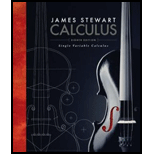
Single Variable Calculus
8th Edition
ISBN: 9781305266636
Author: James Stewart
Publisher: Cengage Learning
expand_more
expand_more
format_list_bulleted
Textbook Question
Chapter 9, Problem 16RE
- (a) The population of the world was 6.1 billion in 2000 and 6.9 billion in 2010. Find an exponential model for these data and use the model to predict the world population in the year 2020.
- (b) According to the model in part (a), when will the world population exceed 10 billion?
- (c) Use the data in part (a) to find a logistic model for the population. Assume a carrying capacity of 20 billion. Then use the logistic model to predict the population in 2020. Compare with your prediction from the exponential model.
- (d) According to the logistic model, when will the world population exceed 10 billion? Compare with your prediction in part (b).
Expert Solution & Answer
Want to see the full answer?
Check out a sample textbook solution
Chapter 9 Solutions
Single Variable Calculus
Ch. 9.1 - Show that y=23ex+e2x is a solution of the...Ch. 9.1 - Verify that y = t cos t t is a solution of the...Ch. 9.1 - (a) For what values of r does the function y = erx...Ch. 9.1 - (a) For what values of k does the function y = cos...Ch. 9.1 - Which of the following functions are solutions of...Ch. 9.1 - Prob. 6ECh. 9.1 - (a) What can you say about a solution of the...Ch. 9.1 - (a) What can you say about the graph of a solution...Ch. 9.1 - A population is modeled by the differential...Ch. 9.1 - The Fitzhugh-Nagumo model for the electrical...
Ch. 9.1 - Prob. 11ECh. 9.1 - Prob. 12ECh. 9.1 - Prob. 13ECh. 9.1 - Suppose you have just poured a cup of freshly...Ch. 9.1 - Psychologists interested in learning theory study...Ch. 9.1 - Von Bertalanffys equation states that the rate of...Ch. 9.1 - Prob. 17ECh. 9.2 - A direction field for the differential equation y...Ch. 9.2 - A direction field for the differential equation...Ch. 9.2 - Match the differential equation with its direction...Ch. 9.2 - Match the differential equation with its direction...Ch. 9.2 - Match the differential equation with its direction...Ch. 9.2 - Prob. 6ECh. 9.2 - Prob. 7ECh. 9.2 - Prob. 8ECh. 9.2 - Prob. 9ECh. 9.2 - Sketch a direction field for the differential...Ch. 9.2 - Prob. 11ECh. 9.2 - Prob. 12ECh. 9.2 - Prob. 13ECh. 9.2 - Prob. 14ECh. 9.2 - Prob. 19ECh. 9.2 - Prob. 20ECh. 9.2 - Prob. 21ECh. 9.2 - Use Eulers method with step size 0.2 to estimate...Ch. 9.2 - Prob. 23ECh. 9.2 - (a) Use Eulers method with step size 0.2 to...Ch. 9.2 - The figure shows a circuit containing an...Ch. 9.3 - Solve the differential equation. 1. dydx=3x2y2Ch. 9.3 - Solve the differential equation. 2. dydx=xyCh. 9.3 - Prob. 3ECh. 9.3 - Solve the differential equation. 4. y + xey = 0Ch. 9.3 - Prob. 5ECh. 9.3 - Solve the differential equation. 6....Ch. 9.3 - Prob. 7ECh. 9.3 - Solve the differential equation. 8....Ch. 9.3 - Prob. 9ECh. 9.3 - Solve the differential equation. 10. dzdt+et+z=0Ch. 9.3 - Find the solution of the differential equation...Ch. 9.3 - Find the solution of the differential equation...Ch. 9.3 - Find the solution of the differential equation...Ch. 9.3 - Find the solution of the differential equation...Ch. 9.3 - Prob. 15ECh. 9.3 - Find the solution of the differential equation...Ch. 9.3 - Find the solution of the differential equation...Ch. 9.3 - Prob. 18ECh. 9.3 - Prob. 19ECh. 9.3 - Find the function f such that f(x) = xf(x) x and...Ch. 9.3 - Solve the differential equation y = x + y by...Ch. 9.3 - Solve the differential equation xy = y + xey/x by...Ch. 9.3 - (a) Solve the differential equationy=2x1y2. (b)...Ch. 9.3 - Solve the equation ey y + cos x = 0 and graph...Ch. 9.3 - Find the orthogonal trajectories of the family of...Ch. 9.3 - Find the orthogonal trajectories of the family of...Ch. 9.3 - Prob. 31ECh. 9.3 - Prob. 32ECh. 9.3 - Prob. 33ECh. 9.3 - Prob. 34ECh. 9.3 - An integral equation is an equation that contains...Ch. 9.3 - Prob. 36ECh. 9.3 - Prob. 37ECh. 9.3 - Prob. 38ECh. 9.3 - Prob. 39ECh. 9.3 - Prob. 40ECh. 9.3 - Prob. 41ECh. 9.3 - Prob. 42ECh. 9.3 - Prob. 43ECh. 9.3 - A certain small country has 10 billion in paper...Ch. 9.3 - A tank contains 1000 L of brine with 15 kg of...Ch. 9.3 - The air in a room with volume 180 m3 contains...Ch. 9.3 - A vat with 500 gallons of beer contains 4% alcohol...Ch. 9.3 - A tank contains 1000 L of pure water. Brine that...Ch. 9.3 - When a raindrop falls, it increases in size and so...Ch. 9.3 - Prob. 50ECh. 9.3 - Prob. 51ECh. 9.3 - A model for tumor growth is given by the Gompertz...Ch. 9.3 - Prob. 54ECh. 9.4 - A population grows according to the given logistic...Ch. 9.4 - A population grows according to the given logistic...Ch. 9.4 - The Pacific halibut fishery has been modeled by...Ch. 9.4 - Suppose a population P(t) satisfies...Ch. 9.4 - Prob. 7ECh. 9.4 - The table gives the number of yeast cells in a new...Ch. 9.4 - Prob. 9ECh. 9.4 - (a) Assume that the carrying capacity for the US...Ch. 9.4 - One model for the spread of a rumor is that the...Ch. 9.4 - Biologists stocked a lake with 400 fish and...Ch. 9.4 - Prob. 13ECh. 9.4 - Prob. 14ECh. 9.4 - Prob. 16ECh. 9.4 - Consider a population P = P(t) with constant...Ch. 9.4 - Let c be a positive number. A differential...Ch. 9.4 - Prob. 21ECh. 9.4 - Prob. 22ECh. 9.4 - Prob. 23ECh. 9.4 - Prob. 24ECh. 9.4 - Prob. 25ECh. 9.5 - Prob. 1ECh. 9.5 - Prob. 2ECh. 9.5 - Prob. 3ECh. 9.5 - Prob. 4ECh. 9.5 - Prob. 5ECh. 9.5 - Prob. 6ECh. 9.5 - Prob. 7ECh. 9.5 - Solve the differential equation. 8. 4x3y + x4y =...Ch. 9.5 - Prob. 9ECh. 9.5 - Prob. 10ECh. 9.5 - Prob. 11ECh. 9.5 - Prob. 12ECh. 9.5 - Prob. 13ECh. 9.5 - Prob. 14ECh. 9.5 - Prob. 15ECh. 9.5 - Prob. 16ECh. 9.5 - Prob. 17ECh. 9.5 - Prob. 18ECh. 9.5 - Prob. 19ECh. 9.5 - Prob. 20ECh. 9.5 - Prob. 21ECh. 9.5 - Prob. 22ECh. 9.5 - Prob. 23ECh. 9.5 - Prob. 24ECh. 9.5 - Prob. 25ECh. 9.5 - Solve the second-order equation xy + 2y = 12x2 by...Ch. 9.5 - Prob. 27ECh. 9.5 - Prob. 28ECh. 9.5 - The figure shows a circuit containing an...Ch. 9.5 - Prob. 30ECh. 9.5 - Prob. 31ECh. 9.5 - Two new workers were hired for an assembly line....Ch. 9.5 - Prob. 33ECh. 9.5 - Prob. 34ECh. 9.5 - Prob. 35ECh. 9.5 - Prob. 36ECh. 9.5 - Prob. 37ECh. 9.5 - To account for seasonal variation in the logistic...Ch. 9.6 - Prob. 1ECh. 9.6 - Prob. 2ECh. 9.6 - Prob. 3ECh. 9.6 - Prob. 4ECh. 9.6 - Prob. 5ECh. 9.6 - A phase trajectory is shown for populations of...Ch. 9.6 - Graphs of populations of two species are shown....Ch. 9.6 - Prob. 8ECh. 9.6 - Populations of aphids and ladybugs are modeled by...Ch. 9.6 - In Example 1 we used Lotka-Volterra equations to...Ch. 9 - (a) What is a differential equation? (b) What is...Ch. 9 - Prob. 2RCCCh. 9 - Prob. 3RCCCh. 9 - Prob. 4RCCCh. 9 - Prob. 5RCCCh. 9 - Prob. 6RCCCh. 9 - (a) Write a differential equation that expresses...Ch. 9 - Prob. 8RCCCh. 9 - Prob. 9RCCCh. 9 - Prob. 1RQCh. 9 - Determine whether the statement is true or false....Ch. 9 - Prob. 3RQCh. 9 - Prob. 4RQCh. 9 - Prob. 5RQCh. 9 - Prob. 6RQCh. 9 - Prob. 7RQCh. 9 - Prob. 1RECh. 9 - Prob. 2RECh. 9 - Prob. 3RECh. 9 - Prob. 4RECh. 9 - Prob. 5RECh. 9 - Prob. 6RECh. 9 - Prob. 7RECh. 9 - Prob. 8RECh. 9 - Prob. 9RECh. 9 - Solve the initial-value problem. 10. (1 + cos x)y...Ch. 9 - Prob. 11RECh. 9 - Prob. 12RECh. 9 - Prob. 13RECh. 9 - Find the orthogonal trajectories of the family of...Ch. 9 - Prob. 15RECh. 9 - (a) The population of the world was 6.1 billion in...Ch. 9 - Prob. 17RECh. 9 - Prob. 18RECh. 9 - Prob. 19RECh. 9 - Prob. 20RECh. 9 - Prob. 21RECh. 9 - Prob. 22RECh. 9 - Prob. 23RECh. 9 - Prob. 24RECh. 9 - Prob. 1PCh. 9 - Prob. 2PCh. 9 - Prob. 3PCh. 9 - Prob. 4PCh. 9 - Prob. 5PCh. 9 - A subtangent is a portion of the x-axis that lies...Ch. 9 - Prob. 7PCh. 9 - Prob. 8PCh. 9 - A dog sees a rabbit running in a straight line...Ch. 9 - Prob. 10PCh. 9 - Prob. 11PCh. 9 - Prob. 12PCh. 9 - Prob. 13PCh. 9 - Prob. 14PCh. 9 - Prob. 15P
Knowledge Booster
Learn more about
Need a deep-dive on the concept behind this application? Look no further. Learn more about this topic, calculus and related others by exploring similar questions and additional content below.Similar questions
- What is the carrying capacity for a population modeled by the logistic equation P(t)=250,0001+499e0.45t ? initial population for the model?arrow_forwardWhat does the y -intercept on the graph of a logistic equation correspond to for a population modeled by that equation?arrow_forwardSales of a video game released in the year 2000 took off at first, but then steadily slowed as time moved on. Table 4 shows the number of games sold, in thousands, from the years 20002010. a. Let x represent time in years starting with x=1 for the year 2000. Let y represent the number of games sold in thousands. Use logarithmic regression to fit a model to these data. b. If games continue to sell at this rate, how many games will sell in 2015? Round to the nearest thousand.arrow_forward
- Does a linear, exponential, or logarithmic model best fit the data in Table 2? Find the model.arrow_forwardTo the nearest whole number, what is the initial value of a population modeled by the logistic equation P(t)=1751+6.995e0.68t ? What is the carrying capacity?arrow_forwardWhat situations are best modeled by a logistic equation? Give an example, and state a case for why the example is a good fit.arrow_forward
- With what kind of exponential model would half-life be associated? What role does half-life play in these models?arrow_forwardWhat might a scatterplot of data points look like if it were best described by a logarithmic model?arrow_forwardWhat is the y -intercept on the graph of the logistic model given in the previous exercise?arrow_forward
arrow_back_ios
arrow_forward_ios
Recommended textbooks for you
 Algebra & Trigonometry with Analytic GeometryAlgebraISBN:9781133382119Author:SwokowskiPublisher:Cengage
Algebra & Trigonometry with Analytic GeometryAlgebraISBN:9781133382119Author:SwokowskiPublisher:Cengage


Algebra & Trigonometry with Analytic Geometry
Algebra
ISBN:9781133382119
Author:Swokowski
Publisher:Cengage
Solve ANY Optimization Problem in 5 Steps w/ Examples. What are they and How do you solve them?; Author: Ace Tutors;https://www.youtube.com/watch?v=BfOSKc_sncg;License: Standard YouTube License, CC-BY
Types of solution in LPP|Basic|Multiple solution|Unbounded|Infeasible|GTU|Special case of LP problem; Author: Mechanical Engineering Management;https://www.youtube.com/watch?v=F-D2WICq8Sk;License: Standard YouTube License, CC-BY
Optimization Problems in Calculus; Author: Professor Dave Explains;https://www.youtube.com/watch?v=q1U6AmIa_uQ;License: Standard YouTube License, CC-BY
Introduction to Optimization; Author: Math with Dr. Claire;https://www.youtube.com/watch?v=YLzgYm2tN8E;License: Standard YouTube License, CC-BY